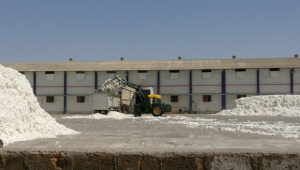During my Summer Vacation I spent a week doing an internship at a cotton mill, which is primarily an export business in India. The company does both the ginning and spinning of cotton to produce yarn. In the 7 days I spent at the factory, I spent my time:
- Discussing with the manager everything about the business side of things. We talked about markets, government subsidies in the business, world competition, the problems they face and how they tackle them.
- Exploring the ginning mill and talking with the manager of the mill (who’d been doing that job with various different companies for more than 25 years) about what work he and different workers in the business do, how they hire and train people, the different machines that are used, and the buying and selling of the cotton from the farmers. Another useful experience with the ginning mill was seeing the workers solve a problem that occured with the hydraulic machine. Seeing them working out the problem and the process in which they made it work as soon as possible was fascinating and insightful.
- I also spent many days at the spinning mill. I talked with the general manager (with +20 years of experience) about his experiences in the business, the problems he deals with and how he handles them, and sat through meetings with supervisors of the factory (who work under him). All of this helped me understand the business side of the mill. I then did two tours of the factory understanding how the machines work and the whole chain process of the mill. I was able to dissect the machines and see how they work and how often they have to clean them. Moreover, I was able to gain a richer experience of the factory when I worked myself as a laborer for a day. I ate with them, learnt a process called piecing and spent the day working. It was quite enlightening and rather uncomfortable, which made it all the more enriching.

L1 – Identify own strengths and develop areas for growth
On the first day I wasn’t sure I would be able to intern there for as long as I was there, all day being able to ask questions that would keep me there for a week. To my surprise, however, I found that I was able to conjure up a multitude of questions about how the machines, their maintenance, and many other topics. I found that I had enough curiosity about the factory and the business that it allowed me to gain an extremely thorough knowledge of the cotton mill business, including the major challenges they face and how they usually tackle them (and even seeing them actually solving those problems). I found myself rather troubled when I was doing the labour work, however. It looked a very simple task, something that requires not much skill and training. I realised later that it was the labourers who were working there for months or years and had gained enough experience to make it look like child’s play. The task that I did was called piecing, and it required a lot of concentration and focus. I will not explain the whole process, but there was also a large degree of risk associated with the task. This was because the machine in which we were doing work was automated, and included parts spinning at the speed of 1912 rotations/s and a lot of heavy machinery, which actually resulted in a small injury. I was actually able to experience the work and realise the whole management work from the outlook of a labourer, which inspired many new questions for me and helped me gained greater insight of the business.
L2 – Demonstrate that challenges have been undertaken developing new skills &
L4-commitment to and perseverance:
As I mention, doing the piecing work was extremely exhausting and difficult. Due to the rather brittle nature of cotton yarn, there has to be a constant temperature at which the mill works (that of 37C). The heat coupled with the deafening machines made working a very draining and difficult task. I saw myself cheering with joy when, after 2 hours of trying, I finally was able to successfully ‘piece’ a broken cotton string. Even though it took me some time to do that again, I was able to learn much better coordination of my eyes and hands as I kept on practising the skill.
The aspect of commitment and perseverance is also associated with my internship because I tried making the work as a labourer as authentic as possible and ate with them, didn’t enter the Air conditioned office until it was time for me to leave, and spent the day talking and working with only them. This was uncomfortable to a certain extent essentially due to their completely different cultural and social background, the exhausting nature of the task, and the amount of time I had to spend doing that. There was also a lot of cotton fly (which is similar to dust in the air and can easily stick to the skin, hair, and can be dangerous when entered into the lungs) in the air. I tried wearing a mask of my handkerchief in order to prevent it from entering my lungs, however, it is very small and the mask wasn’t very efficient. It was all over my skin and my hair and made the experience all the more uncomfortable and exhausting.

L3 – initiate and plan a CAS experience
I had to write an official email, organize proper timings at which I could come, and do background research of the mill before doing the internship. Because of the very efficient working of the factory and its 24 hour working time, I had to make sure not to be a great hindrance to the factory. I was lucky enough to be able to work as a labourer, permission for which had to be asked before. Since the factory was out of the city, I also had to make some living arrangements.
L7-Recognize and consider the ethics of choices and actions
When I laboured I had to make sure that in my attempt to thoroughly understand what working as a labourer was, I did not offend any of the employees through my behaviour or my questions. I had to make sure not to ask a lot of questions in terms of their family background or their education as this is likely to offend them. All of this created the need for me to tread carefully whilst I interning at the factory.